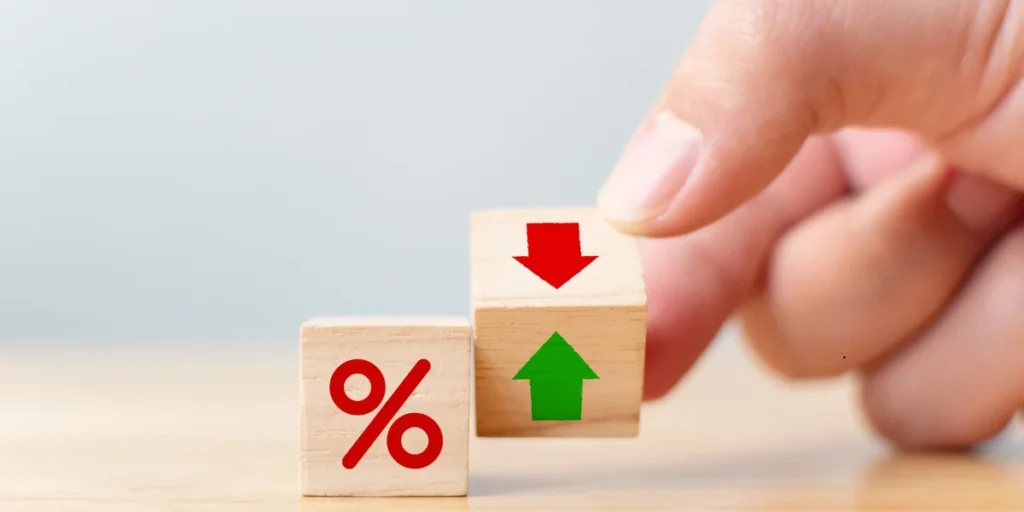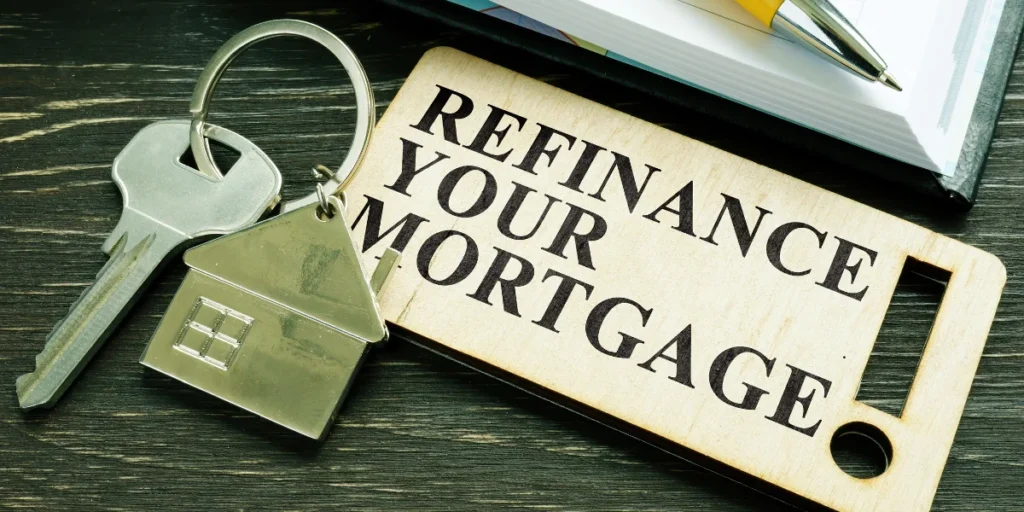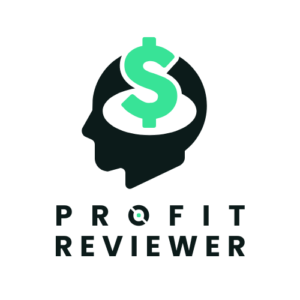Essentially, refinancing mortgage home means moving your remaining loan balance from one bank to another. When homeowners refinance their mortgage, they can either move their existing loan to a new product that the same lender offers or to another lender that takes over the mortgage. Furthermore, refinancing home loan agreements might even come with attractive incentives such as cash back on your new loan.
Whether you’re looking to secure a lower interest rate, access equity in your property, or consolidate debt, the refinance mortgage home process offers various opportunities to improve your financial situation. However, homeowners should carefully consider potential fees involved in the refinancing home loan process, including discharge fees, application fees, valuation fees, and possibly Lenders Mortgage Insurance (LMI) if your loan-to-value ratio is 80% or higher.
What Does It Mean to Refinance a Home Mortgage?

The process of switching out your current house loan for a new one, usually to obtain better terms or access more advantages, is known as refinancing. Through refinancing, homeowners can potentially reduce their interest rates, change loan features, or tap into their home equity.
How Refinancing Works?
During the refinance procedure, money from a new loan is used to pay off your existing mortgage. Generally, refinancing requires applying for a new home loan either with your current lender or a different one. The new lender will assess your application based on factors similar to those in your original loan application, including your credit score, income, and property value. Lenders typically allow borrowers with at least 20% equity to refinance—meaning your loan is no more than 80% of what your home is valued at.
First, your property may need to be revalued as part of the application process. Once approved, your new lender will pay out your existing loan, and you’ll begin making repayments on the new mortgage. This process effectively transfers your debt from one lender to another while maintaining your property as security.
Types of Refinancing Options
Several refinancing options exist to meet different financial goals:
- Rate-and-term refinancing: Replacing your original loan with a new agreement that offers a better interest rate or more favourable terms.
- Cash-out refinancing: Obtaining your home equity through a loan that exceeds your present debt in order to finance investments, renovations, or other costs.
- Cash-in refinancing: Making a lump sum payment to reduce your loan balance, potentially securing lower repayments.
- Debt consolidation refinancing: Combining multiple debts, like credit cards and personal loans, into your mortgage to simplify repayments and potentially reduce overall interest costs.
- Split loans: Dividing your loan into parts with different interest rate types—typically part fixed and part variable.
When Refinancing Makes Sense
Refinancing a home mortgage is particularly beneficial in certain scenarios. Above all, it makes sense when you can get a cheaper interest rate, which could result in thousands of dollars saved over the course of the loan. The Reserve Bank reports existing owner-occupied borrowers are repaying their loans at an average variable rate of 6.39%, whilst the lowest rates in the market stand at 5.75%.
Additionally, refinancing can be advantageous when:
- You need to access equity for home improvements or investments.
- Your fixed-rate term is ending.
- You want to switch between loan types or access features like offset accounts.
- Your financial situation has improved, allowing for better loan terms
- You’re looking to consolidate multiple debts into one manageable payment.
Throughout the refinancing process, it’s crucial to consider any costs involved, including break fees, application fees, and valuation expenses, to ensure the benefits outweigh these expenses.
Why Refinance? Key Benefits and Considerations

Refinancing offers several compelling financial advantages that go beyond just changing lenders. Understanding these benefits alongside potential drawbacks ensures you make an informed decision about your mortgage future.
Lower Interest Rates and Repayments
Securing a lower interest rate remains the primary motivation for refinancing. In fact, over time, even a small 0.5% cut might have a big effect on your finances. For instance, reducing the rate on a AUD 152,899 30-year fixed mortgage from 7% to 5% lowers monthly payments from AUD 1,016 to AUD 819.
Access to Equity for Renovations or Investments
Cash-out refinancing allows homeowners to tap into the equity they have built up in their property. This equity—the difference between your property’s value and remaining mortgage—can fund renovations, investments, or other major expenses. Nevertheless, applications typically require keeping your loan-to-value ratio below 80% to avoid additional costs.
Switching Loan Types or Features
Refinancing offers the opportunity to modify your loan structure to better suit your current needs. You might:
- Convert from variable to fixed rates (or vice versa)
- Add valuable features like offset accounts or redraw facilities
- Create split loans with both fixed and variable portions
- Shorten your loan term without drastically changing repayments
Debt Consolidation Opportunities
Combining higher-interest debts into your mortgage can yield substantial savings. Consequently, consolidating credit card debt (20.49% p.a.) and car loans (9.9% p.a.) into a home loan at 2.5% p.a. could save approximately AUD 5,579 annually in interest charges. This approach also streamlines finances through a single monthly payment rather than managing multiple accounts.
Potential Long-Term Costs
Despite the benefits, refinancing home loan comes with expenses that need to be considered. These range from AUD 252 at the low end to AUD 4,213 at the higher end. Watch for break costs on fixed-rate loans, discharge fees, and application fees. Furthermore, extending your loan term might reduce immediate payments but increase total interest paid over time. Additionally, borrowers with less than 20% equity may face Lenders Mortgage Insurance costs again.
Step-by-Step Guide to Refinancing a Home Mortgage in 2025

Taking action on refinancing mortgage home involves a structured approach to secure optimal results.
Step 1: Review Current Financial Position
Prior to refinancing, thoroughly examine your financial health. Lenders typically assess what they call the ‘three Ps‘: Purpose (the reason for refinancing), Person (your creditworthiness), and Payback (your ability to meet repayments). Check your credit report for accuracy and gather information about your current loan’s interest rate, features, and repayment schedule. Moreover, assess your income, expenses, and existing debts to determine if refinancing aligns with your financial goals.
Step 2: Compare Home Loan Refinance Options
Research different lenders and their offerings through direct enquiries, comparison websites, or mortgage brokers. Look beyond headline rates—consider comparison rates (which include fees), loan features, and potential long-term costs. Additionally, use refinance calculators to calculate potential savings and determine if switching makes financial sense.
Related Article: Mortgage Calculator UK: Estimate Your Monthly Payments with Ease
Step 3: Choose The Right Lender or Broker
A mortgage broker can provide valuable support by comparing loans from numerous lenders (often more than 50 options), negotiating rates, and handling paperwork. Alternatively, approaching lenders directly gives you control over the process. Above all, ensure any broker is licensed—verify this through ASIC’s Professional Registers Search.
Step 4: Submit Refinance Application
Assemble the necessary paperwork, such as evidence of income, current loan statements, bank statements that demonstrate financial activity, and information about property insurance. Your new lender will assess your application based on serviceability and conduct a property valuation. Although some online lenders provide quicker turnaround times, the approval procedure normally takes two to four weeks.
Step 5: Finalise and Sign Your New Loan Contract
Following approval, you’ll receive formal loan documents for review. Seek professional advice before signing to ensure you understand all the terms and conditions. Subsequently, your new lender will organise the discharge of your old loan and the transfer of the mortgage. The settlement process completes when your new lender pays out your existing loan, finalising the refinance.
What to Watch Out for When Refinancing Home Loan
Whilst refinancing can offer substantial benefits, homeowners must carefully consider several potential costs that could impact the overall value of switching loans.
Break Fees and Discharge Costs
Breaking a fixed-rate mortgage early typically incurs substantial break fees. These fees compensate lenders for potential losses and can be pretty significant—especially if interest rates have decreased since you fixed your loan. Additionally, expect to pay a discharge settlement fee (sometimes called a termination fee) when closing your current loan, ranging from approximately AUD 229 to AUD 611. Most lenders charge around AUD 535 for loan discharge fees.
Lenders Mortgage Insurance (LMI)
One expense that catches many borrowers off guard is Lender’s Mortgage Insurance. LMI protects the lender—not you—if you have less than 20% equity in your property. Importantly, LMI is not transferable between lenders. For instance, on an AUD 917,394 loan with 90% LVR, LMI could cost between AUD 15,290 and AUD 22,935. Therefore, if your equity remains below 20%, you may need to pay this substantial fee again when refinancing a home mortgage.
Valuation and Application Fees
Lenders typically charge between AUD 306 and AUD 917 for property valuations. This assessment determines your property’s current market value, which in turn affects your loan-to-value ratio. Concerning application fees, expect to pay between AUD 306 and AUD 1,223, depending on the lender. Some institutions waive these fees as part of promotional offers, yet this often comes with other conditions.
Impact on Loan Term and Total Interest
Unless specifically negotiated, many lenders will reset your loan to a new 25 or 30-year term. Consequently, although your monthly repayments might decrease, you’ll ultimately pay more interest over the extended period. To avoid this pitfall, negotiate a loan term that is similar to your remaining term, rather than accepting a complete reset of the loan.
Conclusion – Refinance Mortgage Home
Refinancing a home mortgage represents a significant financial decision that demands careful consideration. Lower interest rates are advantageous to the majority of homeowners, who may save thousands of pounds over the course of their loan. Beyond rate reductions, refinancing offers flexibility through different loan structures, access to property equity, and debt consolidation opportunities.
Therefore, homeowners should approach the refinancing process methodically. Your current financial situation warrants a thorough assessment before comparing available options. Subsequently, choosing between direct lender contact or broker assistance will streamline your application journey.
Undoubtedly, refinancing is most effective when approached strategically with clear financial objectives in mind. The right refinancing decision could free up monthly cash flow, fund essential life projects, or create significant long-term savings. Armed with this comprehensive understanding of the refinancing process, you can confidently evaluate whether this financial move aligns with your specific circumstances in 2025.
What are the main benefits of refinancing a home mortgage?
Refinancing can offer several advantages, including securing a lower interest rate, reducing monthly repayments, accessing home equity for renovations or investments, switching to a different loan type, and consolidating debts. However, it’s important to weigh these benefits against potential costs and fees associated with refinancing.
How much equity do I need to refinance my home loan?
Typically, lenders prefer borrowers to have at least 20% equity in their property to refinance. This means your loan should be no more than 80% of your property’s current value. Having less than 20% equity may still allow you to refinance, but you might incur additional costs such as Lenders Mortgage Insurance.
What fees should I be aware of when refinancing my mortgage?
When refinancing, be prepared for potential costs such as break fees for fixed-rate loans, discharge costs, valuation fees, application fees, and possibly Lenders Mortgage Insurance if your loan-to-value ratio exceeds 80%. It’s crucial to factor in these expenses when calculating the overall benefit of refinancing.
How long does the refinancing process usually take?
The refinancing process typically takes between 2 and 4 weeks from application to settlement. However, this timeline can vary based on the lender and the complexity of your financial situation. Some online lenders may offer faster turnaround times.
Should I use a mortgage broker when refinancing my home?
It can be beneficial when refinancing, as they can compare loans from numerous lenders (often 50+ options), negotiate rates on your behalf, and handle much of the paperwork. However, you can also approach lenders directly if you prefer more control over the process. Ensure any broker you work with is licensed by checking ASIC’s Professional Registers.




